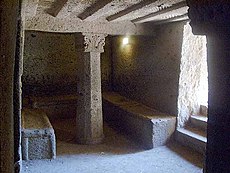Cerveteri
| Cerveteri | |
|---|---|
| Comune | |

Banditaccia Necropolis
|
|
| Location of Cerveteri in Italy | |
| Coordinates: 42°00′N 12°06′E / 42.000°N 12.100°E | |
| Country | Italy |
| Region | Lazio |
| Province / Metropolitan city | Rome |
| Area | |
| • Total | 134.43 km2 (51.90 sq mi) |
| Elevation | 81 m (266 ft) |
| Population (30 September 2015) | |
| • Total | 37,326 |
| • Density | 280/km2 (720/sq mi) |
| Time zone | CET (UTC+1) |
| • Summer (DST) | CEST (UTC+2) |
| Website | Official website |
| Etruscan Necropolises of Cerveteri and Tarquinia | |
|---|---|
| Name as inscribed on the World Heritage List | |
 |
|
| Location | Italy |
| Type | Cultural |
| Criteria | i, iii, iv |
| Reference | 1158 |
| UNESCO region | Europe and North America |
| Inscription history | |
| Inscription | 2004 (28th Session) |
Cerveteri [tʃerˈvɛːteri] is a town and comune of northern Lazio in the region of the Metropolitan City of Rome. Known by the ancient Romans as Caere, and previously by the Etruscans as Caisra or Cisra, and as Agylla (or Άγυλλα) by the Greeks, its modern name derives from Caere Vetus used in the 13th c. to distinguish it from Caere Novum (the current town).
It is famous for the site of the ancient Etruscan city which was one of the most important Etruscan cities with an area more than 15 times larger than today's town.
Caere was one of the city-states of the Etruscan League and at its height, around 600 BC, its population was perhaps around 25,000 - 40,000 people.
The ancient city was situated about 7 km from the sea, a location which made it a wealthy trading town derived originally from the iron ore mines in the Tolfa hills.
It had three sea ports including Pyrgi, connected to Caere by a road approximately 13 km long and 10 metres wide, and Punicum.
Pyrgi was also famous for its sanctuary of monumental temples from 510 BC, built by the king of Caere and dedicated to the goddesses Leucothea and Ilithyia, of which impressive and beautiful sculptures are exhibited at the Villa Giulia.
Little is known of the ancient city although six temples are known from various sources. Two of them have been excavated, one of Hera, the other in the north of the city. Parts of the city walls are still visible today and excavations opened up a theatre. There were three necropoli.
The contents of the tombs excavated, often chaotically and illegally, over the last few centuries have yielded rich and exquisite objects, including ceramics and jewellery which today grace many of the worlds museums. One famous and important work of art is the Sarcophagus of the Spouses.
...
Wikipedia

